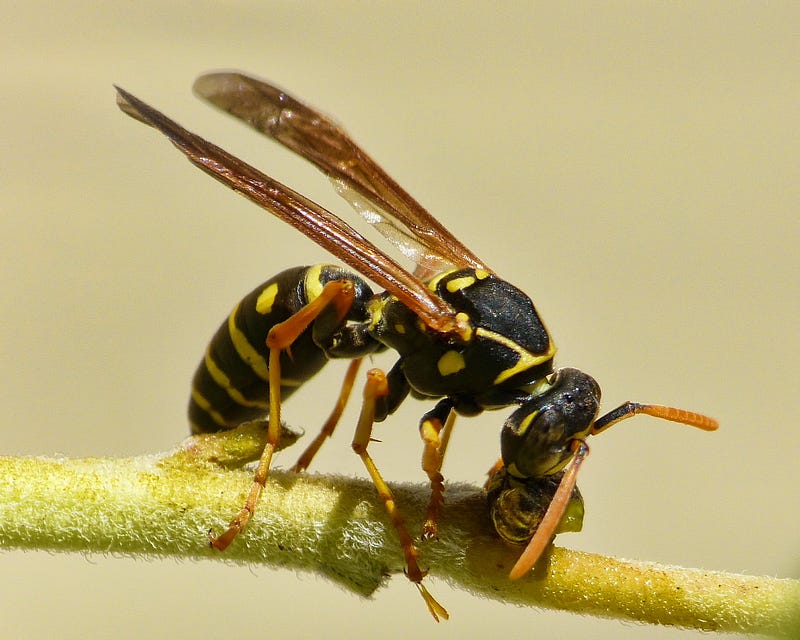The Schmidt sting pain index
By Cerina Karr, Biology, 2023

Almost everybody can recall the first time they were stung by a bee. The sharp pain and soreness that follows a bee sting is enough to render any child in tears. How, though, does the sting of this tiny furry insect compare to something more exotic, such as the tarantula hawk wasp? The name itself is terrifying. Yet, an entomologist by the name of Justin O. Schmidt willingly subjected himself to thousands of stings in order to rank the relative pain of different stinging insects.
An entomologist by the name of Justin O. Schmidt willingly subjected himself to thousands of stings in order to rank the relative pain of different stinging insects.
The Schmidt sting pain index is a scale that ranks the pain of hymenopteran stings. Hymenoptera is the order of insects that includes wasps, bees, and ants. The scale goes from zero to four, with zero meaning the sting is ineffective against humans and four being the most intense pain. While many of the insects included on the scale may appear small and harmless, Schmidt would assure you that appearances can be misleading. He asserted that Paraponera clavata, or the bullet ant, has the most painful sting out of all observed hymenoptera. The bullet ant and the tarantula hawk wasp were rated a four.
The main focus of Schmidt’s early research was to determine relationships between a sting’s lethal toxicity, hemolytic activity, and “algogenicity,” or ability to cause pain. Hemolytic activity refers to the venom’s destruction of red blood cells. The purpose of Schmidt’s scale was to quantify algogenicity in order to relate it to the other two properties. Interestingly, Schmidt found no correlation, suggesting that further research was needed to understand the role of hemolysins in venom.
The purpose of Schmidt’s scale was to quantify algogenicity, or ability to cause pain, in order to relate it to lethal toxicity and hemolytic activity.
Since the scale is based on Schmidt’s subjective experience, it may not be entirely accurate; the degree of pain may vary from person to person. However, in addition to ranking the sting pain, Schmidt provided detailed descriptions of each sting, since different insects may inflict different kinds of pain. For example, after getting stung by Pogonomyrmex badius, the Florida harvester ant, Schmidt wrote: “This extreme pain lasted 4–8 hours and may be likened to pain that might be caused by someone ‘turning a screw into the flesh’ or ‘ripping muscles and tendons.’” Although Schmidt’s scale is subjective, I think we can all agree that we will take his word for it.
In contrast, Schmidt described stings ranked a “one” on his index as “light, ephemeral, almost fruity. A tiny spark has singed a single hair on your arm.” (It makes sense that a man who has experienced the long, excruciating pain of a bullet ant sting might describe a bee sting as “fruity.”)
Logically, one would be wise to avoid the bullet ant, unless you’re as wildly curious as Schmidt.
Logically, one would be wise to avoid the bullet ant, unless you’re as wildly curious as Schmidt. However, the Sateré-Mawé tribe living in the Amazon Rainforest uses the bullet ant’s sting as a rite of passage for men. Hundreds of ants are woven into a glove, and boys must wear the glove for five minutes as they are stung repeatedly. Hours of excruciating pain ensue, often accompanied by disorientation and confusion. Men in this tribe usually go through this ritual at least 20 times throughout their lives.
People seem to be fascinated by stories of pain or danger. Is it because humans enjoy it when others get hurt?
Schmidt theorizes that our fascination with the extreme stems not from an inherently sick or twisted nature, but rather from evolution. People naturally want to learn about potential danger so that they can become knowledgeable enough to avoid them. Although many painful insect stings are not actually lethal, pain is our body’s way of signifying potential damage. Stings are unpleasant to read about, yet it is in our nature to want to learn about it to enhance our long term survival. Accordingly, Schmidt believes his research has applications in human psychology: “It provides a window into understanding ourselves, how we evolved to where we are, and what we might expect in the future.”
DOI: 10.1002/arch.940010205
